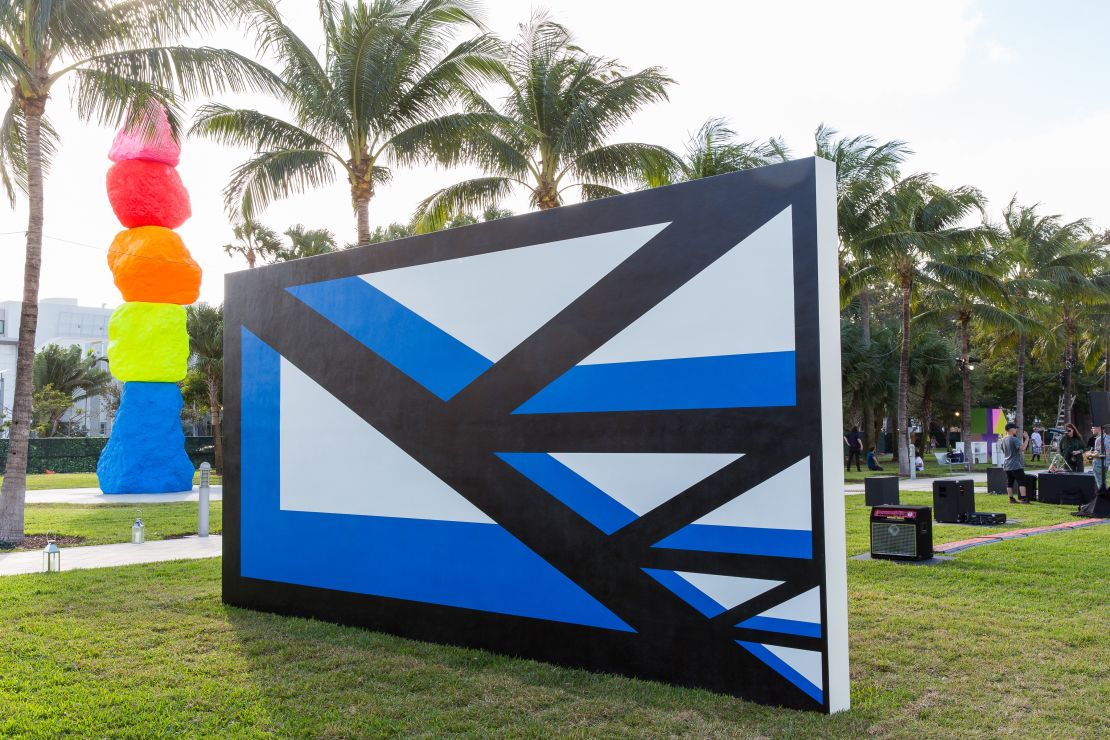This year, Art Basel Miami Beach has taken a cue from David Bowie’s 1969 single “Space Oddity.”
“Ground Control,” a reference to the song’s opening lyrics, is the theme for this year’s Public sector, the portion of the annual mega fair that takes place outdoors on the lawn of The Bass contemporary art museum.
“Bowie’s music, his play with fantasy, identity, gender, and his approach to being a musician and an artist were incredibly influential for a lot of people,” curator and Public Art Fund director Nicholas Baume says. “I did feel like he certainly warranted a gesture of recognition here at Art Basel.”
Figurative forms
The resulting exhibition is not, however, a literal homage to the late pop star. Instead, Baume chose works that represent Bowie’s words thematically.
Claudia Comte’s “128 Triangles and their Demonstration,” a small wall erected at the front of The Bass’ lawn, for example, interprets “ground” in the literal sense – nature, the outdoors.
The geometric motifs repeating on both sides explore the idea that, “Nature looks wild,” she says, “but it’s really highly structured and organized.”
For the most part, however, the show is highly political, looking at “control” as it relates to oppression, or channeling the inherent sadness of Bowie’s character, Major Tom, an astronaut trying to make contact with Earth.

“Here am I floating ‘round my tin can/Far above the moon/Planet Earth is blue/ And there’s nothing I can do,” Bowie sang.
Bowie/Collector: Selected works from David Bowie's private art collection
“His reference to ground control was all about this journey into space, where a human being could use technology in these incredible ways,” Baume says.
“At the same time, he loses contact; he’s disconnected. There’s a simultaneous fascination with the utopianism of technology and its potency, and its other dangerous quality: its effect on subjectivity and how we relate and exist as individuals, which is more true today than it was when Bowie was writing that music.”
A message of hope
Consequently, many of the works reflect aspects of cultural turmoil. The two shackled trees of Yoan Capote’s “Naturaleza Urbana” refer to both physical and mental incarceration, aimed directly at his native Cuba.
Elsewhere, Camille Henrot’s “Contrology,” a flattened bronze figure with its feet in the air, was sculpted to reflect a Monday morning mood, but in this context seems held down by gravity.
Perhaps the centerpiece of the exhibition is Glenn Kaino’s “Invisible Man,” a poignant commentary on racial politics. A cast aluminum figure of a man faces The Bass with his arms raised, an ubiquitous gesture of protest since the fatal police shooting of Michael Brown in 2014.
The front of the figure has been sliced flat and replaced with a mirror, dematerializing his identity in the reflections of the sky and the trees.
But one bright spot does rise 42 feet in the air: Ugo Rondinone’s “Miami Mountain,” five boulders that have been painted DayGlo colors and stacked into a massive totem.
The new permanent commission for The Bass is visible from all parts of the park, even during the occasional Miami storm, offering a beacon of optimism for anyone who cares to look up.
Art Basel Miami Beach is on until Dec. 4, 2016.











!["My God, yeah! I want to sound like that looks" -- David Bowie on Frank Auerbach's work, quoted in the New York Times, 1998. Bowie loved the rich, sculptural effects of Auerbach's paintings, and clearly felt a deep affinity with the artist, whose work could provoke in him a whole gamut of reactions: "It will give spiritual weight to my angst. Some mornings I'll look at it and go, ''Oh, God, yeah! I know!'' But that same painting, on a different day, can produce in me an incredible feeling of the triumph of trying to express myself as an artist." [Ibid]<br /><br />The painting was last exhibited at the Royal Academy, when Bowie lent the work to Auerbach's retrospective in 2001.](https://media.cnn.com/api/v1/images/stellar/prod/160920113713-bowie-collector-1.jpg?q=w_3362,h_4154,x_0,y_0,c_fill/h_447)
![The connection between Bowie and Basquiat has previously been established on film in Julian Schnabel's 1996 film Basquiat, in which David played the role of the young artist's mentor and collaborator, Andy Warhol. <br /><br />It is clear however that Bowie felt a strong connection to the artist and his method: "It comes as no surprise to learn that he [Basquiat] had a not-so-hidden ambition to be a rock musician", wrote Bowie in Modern Painters, 1996, "his work relates to rock in ways that very few other visual artists get near. He seemed to digest the frenetic flow of passing image and experience, put them through some kind of internal reorganization and dress the canvas with this resultant network of chance."](https://media.cnn.com/api/v1/images/stellar/prod/160920114803-bowie-collector-2.jpg?q=w_1992,h_2164,x_0,y_0,c_fill/h_447)






